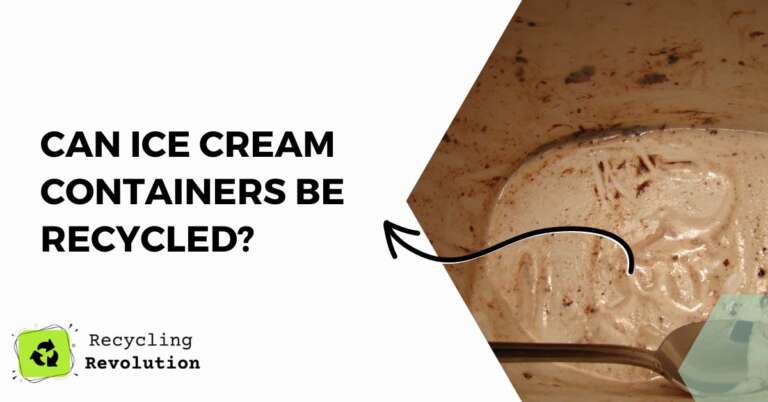Picture this: it’s a warm summer evening, and you’ve just finished enjoying a delicious bowl of ice cream. But now you’re left with an empty container, and you start to wonder, “Can ice cream containers be recycled?”
This question is not only valid, but it’s also important, as recycling and reducing waste are crucial to maintaining a sustainable environment.
Types of Ice Cream Containers
There are three common types of ice cream containers: plastic, paper, and cardboard. Each has its own unique properties and uses. Plastic containers, often made from polypropylene, are durable and moisture-resistant.
Paper and cardboard containers, on the other hand, are typically coated with wax or plastic to prevent leakage. Understanding these differences will help you determine the best way to recycle your ice cream containers.
| Container type | Description | Recyclable? |
|---|---|---|
| Cardboard carton | Paperboard carton typically used for pint-sized containers of ice cream | Yes |
| Plastic tub with metal lid | Plastic container with a metal lid typically used for larger sizes of ice cream | Yes (lid is usually made of steel or aluminum) |
| Plastic tub with plastic lid | Plastic container with a plastic lid typically used for larger sizes of ice cream | Not always (check local recycling guidelines) |
| Single-serve cups and spoons | Plastic cups and spoons typically used for single servings of ice cream | Not always (check local recycling guidelines) |
| Novelty ice cream wrappers | Plastic wrappers for ice cream bars, popsicles, etc. | Not always (check local recycling guidelines) |
Environmental and health Concerns
Here are the environmental concerns and studies that have concluded the environmental impacts on our lives.
Chemical leaching
Plastic ice cream containers may contain chemicals that could leach into the environment and contaminate soil and water. One study published in Environmental Health Perspectives (Rochman et al., 2013) found that chemicals in plastic waste can be ingested by marine life, entering the food chain and potentially affecting human health.
Microplastics
Microplastics are tiny plastic particles that can be ingested by marine life and accumulate in their tissues. According to a study in Environmental Science & Technology (Eriksen et al., 2014), there are more than 5 trillion pieces of plastic debris in the world’s oceans, and microplastics pose a significant threat to marine ecosystems and human health.
Landfill space
Waste from ice cream containers contributes to landfill space, which can lead to the release of greenhouse gases like methane. A study in the journal Waste Management (Chen et al., 2018) found that methane emissions from landfills contribute significantly to climate change, which in turn can have various health impacts, such as heat-related illnesses and vector-borne diseases.
Impact on wildlife
Ice cream container waste, especially when improperly disposed of, can be ingested by wildlife, leading to injury or death. A review published in the journal Environmental Pollution (Gall and Thompson, 2015) highlighted the severe consequences of plastic waste ingestion on marine life, including entanglement and death.
Air pollution from incineration
Incinerating waste, including ice cream containers, can release toxic pollutants into the air, contributing to air pollution and associated health risks.
A study in the journal Atmospheric Environment (Hedman et al., 2006) showed that waste incineration can emit hazardous air pollutants like dioxins, furans, and heavy metals, which can have adverse effects on human health, including respiratory illnesses and cancer.
Recycling Plastic Ice Cream Containers
Recycling plastic ice cream containers can be a bit tricky. Not all types of plastic are recyclable, so it’s important to check the container for the recycling symbol and the number within it.
This will help you determine if your container is accepted by your local recycling facility. Challenges that arise when recycling plastic containers include contamination from leftover ice cream and the difficulty of sorting different types of plastics.
Recycling Paper and Cardboard Ice Cream Containers
Paper and cardboard ice cream containers are often more easily recyclable than their plastic counterparts. Most curbside recycling programs accept these materials, provided they are clean and free from contaminants.
One challenge when recycling paper and cardboard containers, however, is the wax or plastic coating, which can sometimes make them non-recyclable.
Contamination and Preparation
Properly cleaning and preparing your ice cream containers for recycling is essential. Contamination, such as leftover ice cream or a dirty container can make recycling difficult or even impossible.
Make sure to rinse out your containers and remove any residue before recycling to ensure they’re processed correctly.
Local Recycling Policies
Recycling policies can vary depending on your location, which can impact whether your ice cream containers can be recycled. To find out the recycling guidelines and policies in your area, consult your local government’s website or contact your waste management provider.
What Are The Eco Alternatives
There has been an urgent need for action to make containers, especially those of the ice cream variety to make them safer for the world and people.
With microplastics being and the head of the conversation there have been some amazing technological breakthroughs.
Here is a list of eco-friendly alternatives for ice cream containers, demonstrating their commitment to sustainability and reducing packaging waste. Here are some real-world examples:
Ben & Jerry’s: The popular ice cream brand has been using Forest Stewardship Council (FSC) certified paperboard for their pint containers, ensuring that the materials come from responsibly managed forests. Additionally, they are actively researching and testing compostable and recyclable packaging solutions to further reduce their environmental impact.
Häagen-Dazs: In 2019, Häagen-Dazs partnered with Loop, a circular shopping platform, to pilot reusable stainless steel ice cream containers. Customers could order Häagen-Dazs ice cream through the Loop platform, and after consumption, the containers were collected, cleaned, and reused for future orders.
Compostable Containers: Companies like Eco-Products and World Centric offer compostable ice cream containers made from plant-based materials such as sugarcane or bamboo fiber. These containers are certified compostable and can break down in commercial composting facilities.
Cado Ice Cream: Cado, a plant-based ice cream brand, uses containers made from recyclable paperboard. The packaging is designed to be more environmentally friendly compared to traditional plastic containers.
Coolhaus: Coolhaus, an artisanal ice cream brand, uses eco-friendly packaging for their ice cream sandwiches. The wrappers are made from compostable materials, reducing the environmental impact of their products.
Yorica: Yorica, a UK-based ice cream company, serves their ice cream in biodegradable, compostable tubs and spoons. They also offer edible waffle cones as an alternative to disposable containers.
Conclusion
In summary, recycling ice cream containers is an important step toward reducing waste and minimizing your environmental impact. Whether your container is made from plastic, paper, or cardboard, it’s crucial to clean and prepare it for recycling properly.
Do your part by following local recycling policies and guidelines and encourage others to do the same!
FAQs
What can I do with empty ice cream containers?
Empty ice cream containers can be recycled, upcycled, or repurposed for various uses such as storage containers, planters, or craft projects. Be sure to check local recycling policies to determine if your container is recyclable in your area.
Can waxed ice cream containers be recycled?
Waxed ice cream containers may not be recyclable in all areas due to the wax coating. Check with your local recycling facility to see if they accept waxed paper or cardboard containers.
Is it safe to reuse ice cream containers?
Yes, it is generally safe to reuse ice cream containers, provided they are thoroughly cleaned and free from any contaminants. However, be cautious when using containers for storing food or other sensitive items, as plastic may degrade over time, potentially releasing harmful chemicals.
What plastic is ice cream containers made from?
Plastic ice cream containers are typically made from polypropylene (PP), which is identified by the recycling symbol with the number “5” inside it. Always check the container for the recycling symbol to determine its specific type of plastic and whether it is accepted by your local recycling facility.

